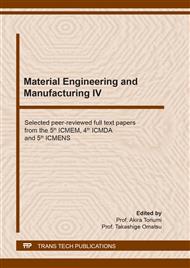[1]
D.A. Yaseen, M. Scholz, Textile dye wastewater characteristics and constituents of synthetic effluents: a critical review, Int. J. Environ. Sci. Technol. 16 (2019) 1193–1226.
DOI: 10.1007/s13762-018-2130-z
Google Scholar
[2]
B. Lellis, C.Z. Fávaro-Polonio, J.A. Pamphile, J.C. Polonio, Effects of textile dyes on health and the environment and bioremediation potential of living organisms, Biotechnol. Res. Innov. 3 (2019) 275–290.
DOI: 10.1016/j.biori.2019.09.001
Google Scholar
[3]
K.A. Adegoke, O.S. Bello, Dye sequestration using agricultural wastes as adsorbents, Water Resour. Ind. 12 (2015) 8–24.
DOI: 10.1016/j.wri.2015.09.002
Google Scholar
[4]
G. Mezohegyi, F.P. van der Zee, J. Font, A. Fortuny, A. Fabregat, Towards advanced aqueous dye removal processes: A short review on the versatile role of activated carbon, J. Environ. Manage. 102 (2012) 148–164.
DOI: 10.1016/j.jenvman.2012.02.021
Google Scholar
[5]
P.K. Yeow, S.W. Wong, T. Hadibarata, Removal of azo and anthraquinone dye by plant biomass as adsorbent – a review, Biointerface Res. Appl. Chem. 11 (2021) 8218–8232.
DOI: 10.33263/briac111.82188232
Google Scholar
[6]
M.R. Esfahani, S.A. Aktij, Z. Dabaghian, M.D. Firouzjaei, A. Rahimpour, J. Eke, I.C. Escobar, M. Abolhassani, L.F. Greenlee, A.R. Esfahani, A. Sadmani, N. Koutahzadeh, Nanocomposite membranes for water separation and purification: Fabrication, modification, and applications, Sep. Purif. Technol. 213 (2019) 465–499.
DOI: 10.1016/j.seppur.2018.12.050
Google Scholar
[7]
Y. Wen, J. Yuan, X. Ma, S. Wang, Y. Liu, Polymeric nanocomposite membranes for water treatment: a review, Environ. Chem. Lett. 17 (2019) 1539–1551.
DOI: 10.1007/s10311-019-00895-9
Google Scholar
[8]
P.R. Yaashikaa, P.S. Kumar, S. Varjani, A. Saravanan, A critical review on the biochar production techniques, characterization, stability and applications for circular bioeconomy, Biotechnol. Reports. 28 (2020) e00570.
DOI: 10.1016/j.btre.2020.e00570
Google Scholar
[9]
A. Fdez-Sanromán, M. Pazos, E. Rosales, M.A. Sanromán, Unravelling the environmental application of biochar as low-cost biosorbent: A review, Appl. Sci. 10 (2020) 1–22.
DOI: 10.3390/app10217810
Google Scholar
[10]
H.B. Quesada, T.P. de Araújo, D.T. Vareschini, M.A.S.D. de Barros, R.G. Gomes, R. Bergamasco, Chitosan, alginate and other macromolecules as activated carbon immobilizing agents: A review on composite adsorbents for the removal of water contaminants, Int. J. Biol. Macromol. 164 (2020) 2535–2549.
DOI: 10.1016/j.ijbiomac.2020.08.118
Google Scholar
[11]
T. Ramdhan, S.H. Ching, S. Prakash, B. Bhandari, Physical and mechanical properties of alginate based composite gels, Trends Food Sci. Technol. 106 (2020) 150–159.
DOI: 10.1016/j.tifs.2020.10.002
Google Scholar
[12]
C.F. Mok, Y.C. Ching, F. Muhamad, N.A. Abu Osman, N.D. Hai, C.R. Che Hassan, Adsorption of Dyes Using Poly(vinyl alcohol) (PVA) and PVA-Based Polymer Composite Adsorbents: A Review, J. Polym. Environ. 28 (2020) 775–793.
DOI: 10.1007/s10924-020-01656-4
Google Scholar
[13]
K.B. Tan, M. Vakili, B.A. Horri, P.E. Poh, A.Z. Abdullah, B. Salamatinia, Adsorption of dyes by nanomaterials: Recent developments and adsorption mechanisms, Sep. Purif. Technol. 150 (2015) 229–242.
DOI: 10.1016/j.seppur.2015.07.009
Google Scholar
[14]
Y. Yue, J. Han, G. Han, A.D. French, Y. Qi, Q. Wu, Cellulose nanofibers reinforced sodium alginate-polyvinyl alcohol hydrogels: Core-shell structure formation and property characterization, Carbohydr. Polym. 147 (2016) 155–164.
DOI: 10.1016/j.carbpol.2016.04.005
Google Scholar
[15]
Y. Tong, P.J. McNamara, B.K. Mayer, Adsorption of organic micropollutants onto biochar: A review of relevant kinetics, mechanisms and equilibrium, Environ. Sci. Water Res. Technol. 5 (2019) 821–838.
DOI: 10.1039/c8ew00938d
Google Scholar
[16]
N. Ayawei, A.N. Ebelegi, D. Wankasi, Modelling and Interpretation of Adsorption Isotherms, J. Chem. 2017 (2017) 1–11.
DOI: 10.1155/2017/3039817
Google Scholar
[17]
S. Majumdar, U. Saikia, D. Mahanta, Polyaniline-Coated Filter Papers: Cost Effective Hybrid Materials for Adsorption of Dyes, J. Chem. Eng. Data. 60 (2015) 3382–3391.
DOI: 10.1021/acs.jced.5b00645
Google Scholar
[18]
A. Onur, K. Shanmugam, A. Ng, G. Garnier, W. Batchelor, Cellulose fibre- perlite depth filters with cellulose nanofibre top coating for improved filtration performance, Colloids Surfaces A Physicochem. Eng. Asp. 583 (2019) 123997.
DOI: 10.1016/j.colsurfa.2019.123997
Google Scholar
[19]
C. Vilela, C. Moreirinha, A. Almeida, A.J.D. Silvestre, C.S.R. Freire, Zwitterionic nanocellulose-based membranes for organic dye removal, Materials (Basel). 12 (2019).
DOI: 10.3390/ma12091404
Google Scholar
[20]
G. Shi, C. Ruan, S. He, H. Pan, G. Chen, Y. Ma, H. Dai, X. Chen, X. Yang, Zr-based MOF @ carboxymethylated filter paper: Insight into construction and methylene blue removal mechanism, Colloids Surfaces A Physicochem. Eng. Asp. 613 (2020) 126053.
DOI: 10.1016/j.colsurfa.2020.126053
Google Scholar
[21]
L. Yang, C. Chen, Y. Hu, F. Wei, J. Cui, Y. Zhao, X. Xu, X. Chen, D. Sun, Three-dimensional bacterial cellulose/polydopamine/TiO2 nanocomposite membrane with enhanced adsorption and photocatalytic degradation for dyes under ultraviolet-visible irradiation, J. Colloid Interface Sci. 562 (2020) 21–28.
DOI: 10.1016/j.jcis.2019.12.013
Google Scholar
[22]
Q.Q. Zhang, Y.J. Zhu, J. Wu, Y.T. Shao, L.Y. Dong, A new kind of filter paper comprising ultralong hydroxyapatite nanowires and double metal oxide nanosheets for high-performance dye separation, J. Colloid Interface Sci. 575 (2020) 78–87.
DOI: 10.1016/j.jcis.2020.04.079
Google Scholar


